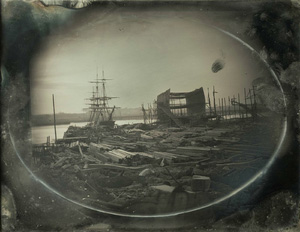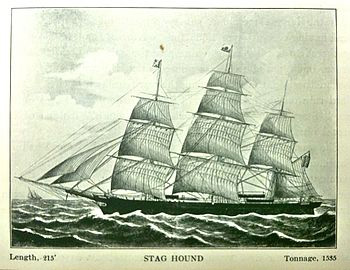Donald McKay is the man who stood between the 1812 frigates of Joshua Humphreys and the 1880s yachts of Nathaniel Herreshoff. Between the War of 1812 and the great age of yachts, American commerce blossomed. Wars of cannons were replaced by wars of business. Our American ships went all over the seas, from New York to California, from California to China. The demand for lumber and whale oil was at an all-time high. Immigrants left England for America and Australia. All of this trade and travel required great ships.
 |
Donald McKay by Southworth & Hawes, c1850-1855
[Some Images Do Not Enlarge] |
Donald McKay was born on Novia Scotia in 1810. As a boy standing on the shore, he saw the great square riggers, the topsail schooners, and the fishing schooners of Canada. Naturally, he came down to the shipyards to apply for a job. He probably saw the Baltimore schooners with their new sharp bow, designed to clip over the waves instead of shoving the water aside. The term 'clipper' came from John Dryden, the world's most unfortunate poet (he had to follow Shakespeare, Milton, and John Donne. That's like hitting after Mantle and Maris-how you gonna follow them?). He had written about the motion of a falcon:
And with her eagerness the quarry missed, Straight flies at check, And clips it down the wind...
Young Donald saw these schooners. They were considered small, usually 150-200 tons. In 1814 the Chasseur was launched in Baltimore (It may have a French name because the clipper schooners of Baltimore were based on French luggers). She was instantly famous in the tales of her speed and deep keel, enabling her to sail swiftly toward the wind. Baltimore clippers followed after her lead, although cargo space was narrow-Americans have always loved speed. And then in 1819, while Donald was still learning the shipbuilding craft, trade opened up between England, India and China. The result were British built narrow sharp ships, the first being the Transit of 1819.
 |
Shipyard |
In 1826 Donald moved to New York for work at the shipyard of Brown & Bell and Watts. This yard was his education. In order for a sizeable ship to be fast, the hull had to be smooth without allowing the friction of the water to build up anywhere along the waterline. That meant the keel had to be not just strong but the keel joinery had to enable the moisture in the wood grain to work toward the ends, thus cramming the joints together. If the joint wasn't cut with this in mind the keel pieces would shrink, working away from each other, cramping the frames and thus the planks. With a 150 footer, once the planks went on the crews on one side of the keel couldn't even see those on the other side. This meant any mistake or misalignment would be built in-correcting it might mean dismantling 2 or 3 weeks of work. So the yard owner depended on his shipwrights and foremen a great deal. Swollen planking could be faired to a point but if a keel joint suffered or a frame was the wrong size or shape, it would crack under pressure-men would lose their lives. Donald must have learned a great deal in this yeard. Meanwhile the Ann McKim was being built in Baltimore. She was all of 494 tons by enlarging the lines of the 1819 Baltimore clippers. The bow was sharp and hollow, the stern raked, and the rig of square sails. The McKim was not copied but talked about around the docks for several years. In 1839 the Scottish got into the act, designing the Scottish Maid for travel between Aberdeen and London where speed was everything. Then in 1841 fortune smiled on Donald. He opened his own shipyard at just the right time. In 1839 American shipyards built clippers of 600 tons or more, the first being Akbar, at 650 tons. In order to compete in the China tea trade, the American clippers lengthened the bow above the waterline, drew out a sharp forefoot, moving the greatest breadth aft of midpoint. Now it was time for Donald to become famous. The issue always was-how much cargo for how much speed? More cargo meant profits, but if the contract went to a faster ship, the trip to China was simply an extravagant expense. So Donald made a decision: instead of narrowing the cargo space, he gave his huge clippers deadrise. Moderate deadrise was called a 'medium' clipper; the great deadrise of Stag Hound gave it the label of 'extreme' clipper. And it was.
You can see the deadrise, almost like a Chesapeake crabbing skiff. Stag Hound was the only extreme clipper Donald designed, with 40 inches from the half floor. A newspaper of the day said, 'Her model may be said to be the original of a new idea in naval architecture... she is longer and sharper than any other vessel of the merchant service in the world, while her breadth of beam and depth of hold are designed with special reference to stability.' The Stag Hound actually carried too much sail and rig. In bad weather, while sailing from New York to California, she lost her main topmast and three topgallant masts. Still, with jury rigging, she got to California in 108 days, frequently logging 16-17 knots.
 |
Yet, Donald never designed another extreme clipper. As a shipyard owner and operator, he was kind to his men. He turned to a different style of clipper, less extreme but nearly guaranteed to carry more cargo and reach port safely to insure profit. He kept his men working, paying them generously for the times. So, from 1850 onward Donald designed his clippers to have greater depth of hold with less deadrise. By 1854, the other American yards followed Donald's lead, but by this time he had triumphed with the majestic Flying Cloud.
 |
Flying Cloud |
 |
Flying Cloud Lines |
Donald's yard built the Cloud in 100 days, an amazing feat. Just getting that much wood in the proper pieces, lengths and shapes was a job. To array the wood, get the steam box percolating, arranging the men and stilts and iron bolts was a job. And then, to work that fast meant no one could have any doubts in their minds, there could be no hesitation about the lines, the lofting, the planking. Donald had a reputation for working right with his men, encouraging them, rewarding them with good wages and a life of work that meant something to the country. The Flying Cloud was not quite so slippery as the Stag Hound in light air, but in heavy air there was none like her. The Cloud sailed from New York to San Francisco in 89 days 8 hours, a record that lasted from 1854 to 1989. The captain was Josiah Creesy, while the navigator was his wife, Eleanor.
 |
Great Republic |
In 1853 Donald launched the largest wooden clipper ship ever, the Great Republic. To give you an idea of how huge this ship was, it required 1.5 million tons of pine and 336 tons of iron. The GR was a 4 decked clipper barque of 4555 tons at registry. She was fast enough to outsail most steamers of her day. She sailed from New York to Liverpool in 13 days. In one voyage around the horn of South America, she logged 413 nautical miles in one day. The GR opened the last chapter in the great age of clipper ships. She was involved in passage to Australia. In 1849 gold had been discovered in California, triggering the gold rush of '49-thus the name of the San Francisco 49ers NFL team. Now geologists and soldiers of fortune looked for gold anywhere, finding it in Australia in 1851. Suddenly, anyone willing to forego their lands and life in the homeland got on board a clipper for Australia. The accommodations were not luxurious.
This is a drawing of the 'steerage,' an aft compartment where too many families got stuffed in too small a place. It was crowded, and in storms it was wet, damp, and frightening for children. Advertising flyers for these 'emigrant ships (as it was spelled then)' usually lied about the accommodations. Passengers were expected to cook their own food, but if someone got seasick they didn't want to eat. Bathroom facilities were crude and unprivate, with the stench from hay rotting due to seaspray, bad food and unbathed passengers being more than most men could stand.
 |
However, all good things become other things. In 1869 the Suez Canal opened. This enabled the steamers to make up to windward what they lacked against the clippers downwind. After 1870 the clippers specialized only in carrying immigrants from England to Australia and New Zealand. American-built clippers were sold to British firms who specialized in this trade. By the 1880s the profits disappeared and the ships were no longer seaworthy. The days of those tall bright sails flaring in the eyes of the old seamen were over. And yet the clippers have stayed in the imagination. Possibly this is because the clippers with their huge square sails flying in ocean winds represented an age in which ordinary men took on extraordinary adventure. The clippers changed peoples' lives, they altered the history of nations, they created new countries while the suffering of change has disappeared like the wake of great ships.

|

